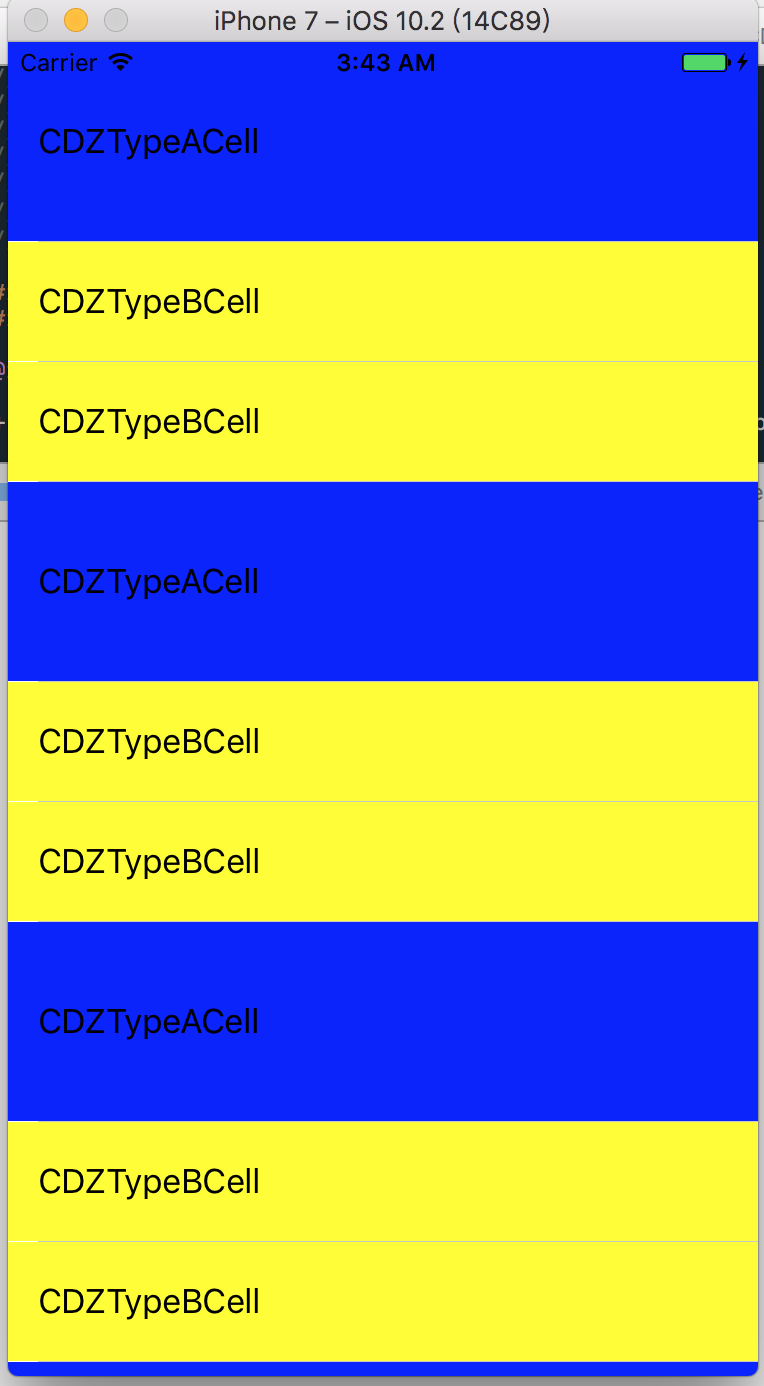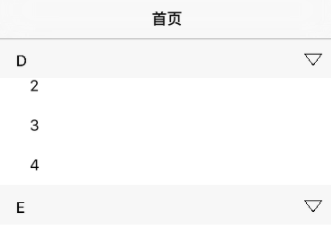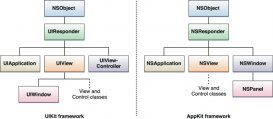前言
我们在项目中偶尔需要让tableview里支持不同种类的cell,比如微博的原创微博和别人转发的微博,就是两种cell。又或是类似支付宝的的timeline也有各种类型的cell。在同一个tableview里实现不同种类的cell,一般有两种方法,一种是把所有种类的cell先注册了,再根据不同的identifer去加载cell,一种是在init时创建不同的identifer的cell。
效果图如下:

准备工作
创建一个基类的cdzbasecell,基类cell拥有一些共用的属性和方法,如持有model,解析model。
创建不同的子类cell,以两个子类cdztypeacell cdztypebcell 为例,继承自cdzbasecell,重写一些方法,如高度,显示视图等等。
datasource中准备好判断index所在的cell种类的方法(如根据model的type属性等)
|
1
2
3
4
5
6
7
8
9
10
11
12
13
14
15
16
17
18
19
20
21
|
- (class)cellclassatindexpath:(nsindexpath *)indexpath{ cdztableviewitem *item = [self itematindexpath:indexpath]; switch (item.type) { case typea:{ return [cdztypeacell class]; } break; case typeb:{ return [cdztypebcell class]; } break; }}- (cdztableviewitem *)itematindexpath:(nsindexpath *)indexpath{ return self.itemsarray[indexpath.row];}- (nsstring *)cellidentiferatindexpath:(nsindexpath *)indexpath{ return nsstringfromclass([self cellclassatindexpath:indexpath]);} |
方法一:先注册,根据identifer去加载不同的cell
先在tableview创建时注册需要的不同种类,再判断index对应的种类,再根据identifer加载子类cell。
|
1
2
|
[self.tableview registerclass:[cdztypeacell class] forcellreuseidentifier:nsstringfromclass([cdztypebcell class])];[self.tableview registerclass:[cdztypebcell class] forcellreuseidentifier:nsstringfromclass([cdztypebcell class])]; |
并在- (uitableviewcell *)tableview:(uitableview *)tableview cellforrowatindexpath:(nsindexpath *)indexpath中根据重用标识加载cell。
|
1
2
3
4
5
|
- (uitableviewcell *)tableview:(uitableview *)tableview cellforrowatindexpath:(nsindexpath *)indexpath{ cdzbasecell *cell = [tableview dequeuereusablecellwithidentifier:[self cellidentiferatindexpath:indexpath] forindexpath:indexpath]; cell.item = [self itematindexpath:indexpath]; return cell;} |
方法二:在init时创建不同identifer的cell
在- (uitableviewcell *)tableview:(uitableview *)tableview cellforrowatindexpath:(nsindexpath *)indexpath中判断cell是否为nil,并根据index所在cell的种类初始化cell和其identifer。
|
1
2
3
4
5
6
7
8
9
|
-(uitableviewcell *)tableview:(uitableview *)tableview cellforrowatindexpath:(nsindexpath *)indexpath{ cdzbasecell *cell = [tableview dequeuereusablecellwithidentifier:[self cellidentiferatindexpath:indexpath]]; if (!cell) { class cls = [self cellclassatindexpath:indexpath]; cell = [[cls alloc]initwithstyle:uitableviewcellstyledefault reuseidentifier:[self cellidentiferatindexpath:indexpath]]; } cell.item = [self itematindexpath:indexpath]; return cell;} |
源码下载
所有源码和demo
总结
个人更喜欢第二种,苹果官方文档也推荐第二种方法去重用cell。我觉得优点是一个是在tableview划分mvc架构时,tableview创建时不需要知道cell的类型,而只需要知道datasouce,而datasource才是需要去分配cell类型的。第二个是tableviewcell的初始化方法并非只能用initwithstyle(collectionview必须先注册的原因则在于初始化方法只有initwithframe)。而使用了注册,则是在复用池空时默认调用initwithstyle的方法,如果需要用别的方法初始化就不可以了。第一种方法可以用在有一些库需要先注册后才能调用的,比如自动计算cell高度的库fdtemplatelayoutcell。
好了,以上就是这篇文章的全部内容了,希望本文的内容对大家的学习或者工作能带来一定的帮助,如果有疑问大家可以留言交流,谢谢大家对服务器之家的支持。
原文链接:http://www.jianshu.com/p/87ea0e3a0ab3
















